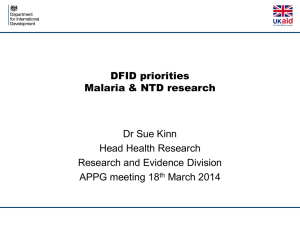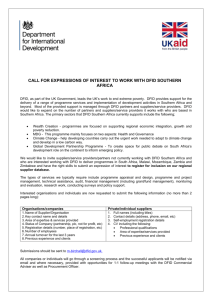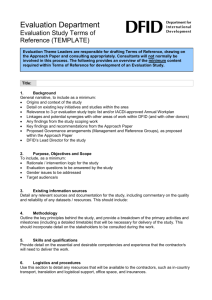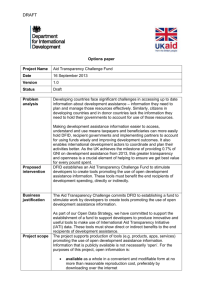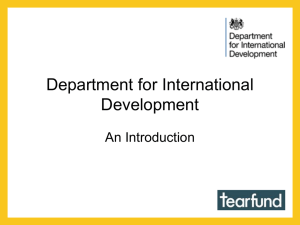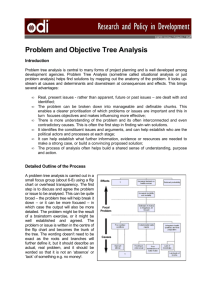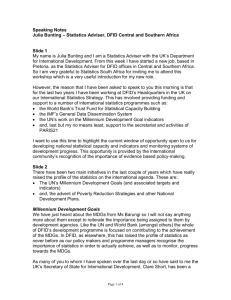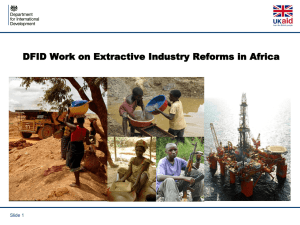Meeting Minutes
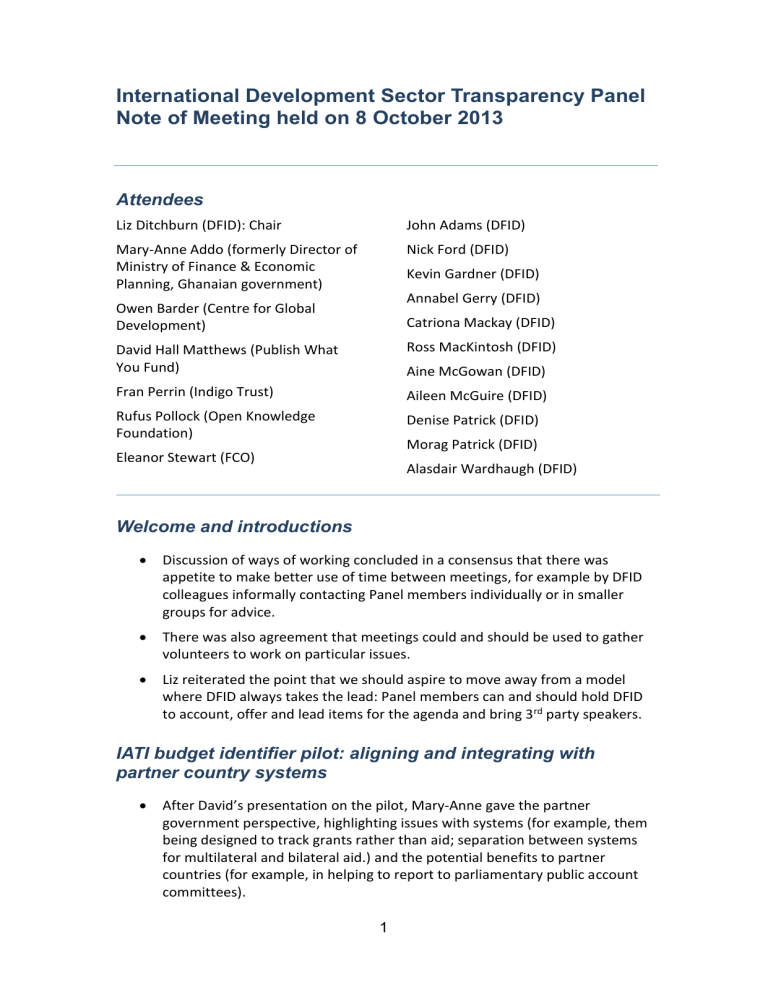
International Development Sector Transparency Panel
Note of Meeting held on 8 October 2013
Attendees
Liz Ditchburn (DFID): Chair
Mary-Anne Addo (formerly Director of
Ministry of Finance & Economic
Planning, Ghanaian government)
Owen Barder (Centre for Global
Development)
David Hall Matthews (Publish What
You Fund)
Fran Perrin (Indigo Trust)
Rufus Pollock (Open Knowledge
Foundation)
Eleanor Stewart (FCO)
John Adams (DFID)
Nick Ford (DFID)
Kevin Gardner (DFID)
Annabel Gerry (DFID)
Catriona Mackay (DFID)
Ross MacKintosh (DFID)
Aine McGowan (DFID)
Aileen McGuire (DFID)
Denise Patrick (DFID)
Morag Patrick (DFID)
Alasdair Wardhaugh (DFID)
Welcome and introductions
Discussion of ways of working concluded in a consensus that there was appetite to make better use of time between meetings, for example by DFID colleagues informally contacting Panel members individually or in smaller groups for advice.
There was also agreement that meetings could and should be used to gather volunteers to work on particular issues.
Liz reiterated the point that we should aspire to move away from a model where DFID always takes the lead: Panel members can and should hold DFID to account, offer and lead items for the agenda and bring 3 rd party speakers.
IATI budget identifier pilot: aligning and integrating with partner country systems
After David’s presentation on the pilot, Mary-Anne gave the partner government perspective, highlighting issues with systems (for example, them being designed to track grants rather than aid; separation between systems for multilateral and bilateral aid.) and the potential benefits to partner countries (for example, in helping to report to parliamentary public account committees).
1
There was agreement that DFID could help create in-country leadership around this issue, perhaps with Mary-Anne as a potential champion.
There were different perspectives on the right balance between completing the pilot quickly and ensuring it is fully comprehensive.
Owen emphasised that it ought to be regarded as essential for donors to understand and publish the flow of the aid they supply through partner country budgets.
Annabel highlighted the separation between open data and open budget communities. DFID is working with ONE to address fiscal transparency more broadly and to bridge the gap between the two communities. She also warned that complications caused by different charts of accounts in different countries shouldn’t be underestimated.
John took an action point to consider points raised around whether DFID’s process for mapping aid flows to country budgets should be fully automated or require manual verification by project officers.
Fran asked whether we are engaging any NGOs in the pilot. Capturing their user needs now could help influence partner country governments to improve budget transparency.
Rufus challenged the idea that a good pilot (achieving complete mapping of aid flows to budget) is essential. Instead, we should identify user need, even in one area, and address that need first. Data can be published before the mapping is complete. There are advantages to publishing the raw data, for example that many more minds are available to contribute.
Liz summarised: there is a tactical imperative to deliver a good pilot for
International Aid Transparency Initiative (IATI) purposes and to publish (even incomplete) data quickly. She pointed out that it was still challenging to get our own chart of accounts right every time, and so adding in partner country accounts as well will be a challenge – but it’s necessary
Improve supplier transparency
After Nick’s presentation on supplier transparency, the following questions/issues were raised:
1.
(Owen) sub-contractors and the supply chain. The IATI declaration includes passing obligation for transparency down the chain. Are we doing this with suppliers?
2.
(Owen) Commercial confidentiality, and the importance of writing transparency into contracts from the beginning. What is it legitimate for companies to keep private?
3.
(David) Which fields are not included?
4.
Will suppliers be expected to publish to IATI? When?
2
5.
(Fran) How are we dealing with suppliers who supply to multiple donors?
6.
(Rufus) This is a big issue generally in government transparency: DFID is blazing a trail.
Nick’s responded that our priority is for suppliers to publish something: the confidentiality issue, and precisely which information will be required are still being worked out. Some of the participants in the pilot do work with other donors, and how to make the best use of this opportunity is something to be considered in the future.
However, there will be an expectation during the pilot that transparency continues down the supply chain, with the pilot testing a second tier publication. This has been written into contracts.
Owen wondered whether ‘just publish something for now’ was the right approach:
DFID has enormous power and could perhaps be more ambitious. His first choice would be to get transparency commitments written into contracts now; his second to make it clear at the tendering stage that preference would be given to suppliers able to offer transparency.
Nick, in response to Owen’s comment, advised that DFID is being firm with suppliers on transparency and driving forward with the pilot and subsequent wider roll out, but DFID needs to understand any potential EU Procurement Regulation issues with stronger enforcement in terms and conditions. DFID is investigating this with legal colleagues.
Mary Anne, Own Barder and Rufus Pollock volunteered to help take this work forward and be involved in supplier workshops as appropriate.
Aid Transparency Challenge Fund
Morag outlined four options for the Challenge Fund:
1) Offer prizes for developing tools. Advantages: speed of delivery, would stimulate lots of ideas, creating buzz, good story to tell. Disadvantages: stronger on what we want to do than on the difference we would make, and the need we are trying to address. It’s a crowded field – how would we add value? The model (which includes things like hackathons and datapaloozas) is good at generating innovative ideas, but there’s little evidence it creates tangible and sustainable positive change.
2) Same as 1 but with more supplier and user engagement at early
planning stage, to be clearer on needs and outcomes. Advantages: relatively quick, again would stimulate good ideas. Disadvantage: user need is only addressed in superficial form – not really embedded throughout project.
3) A case study approach. Identifying DFID country offices to work with and embedding user needs from very beginning in order to be clear about the short, medium and long term outcomes required. Advantage: addresses user need and may be more likely to result in useful tools. Disadvantages:
3
slower to deliver, may result in fewer tools being generated. It’s possible we may even discover we don’t need new tools but should build capacity to use current tools better.
4) Build on existing work to achieve a combination of generating ideas and buzz and delivering tools fast (option 1), but still embedded in user need and making a real difference (option3). For example: a.
build on Making All Voices Count, tweaking the Innovation component to create tools using IATI data specifically, and b.
case studies - work with a small number of DFID country offices to identify specific users and their needs for open development assistance data, tools or other products, and from that set and measure the desired outcomes.
There was a consensus that bits of option 2 or 4 would work best. However, there was some excitement at the idea of holding events in partner countries, and agreement that using partner country talent would be essential.
Fran was wary of focusing too specifically on IATI data. She also suggested it might be helpful to think in terms of partnerships rather than tools.
Rufus and Mary Anne wanted to be clearer about what the Fund was trying to achieve and also questioned whether creating tools was the right focus.
Rufus, Mary Anne and Fran volunteered to help take forward this area of work.
Concluding remarks, forward agendas, date of next meeting
There was agreement that the next meeting would be held in the second half of
January. One agenda item will be ‘ways of working’, with further discussion on how to optimise the use of panel members’ precious time between meetings.
4
